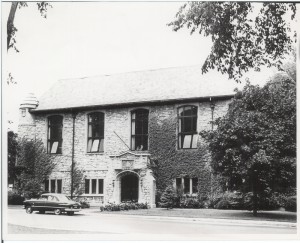Period : After 1950
The world of women’s sports has a long history of attracting women who defied constructions of femininity that would have removed them from the playing field and anchored them firmly in the kitchen. Serious athletics requires an intense commitment of time and energy, requiring athletes to make a whole host of decisions which, in the past, often placed them far outside of heterosexual norms. As Donna, a former Physical Education prof at Queen’s, explains, “Part of it [the predominance of lesbians in sport] is that you don’t have to balance a heterosexual social life with your sport life.”
Many varsity players and the women who coached them were gay. It was not surprising, therefore, that many lesbians would find places for themselves in the Queen’s Physical Education department and on varsity sports teams. Although the department housed a large percentage of lesbian staff and a sizeable number of lesbian students, a code of silence surrounded the issue of ‘alternative’ sexualities. Lesbian students, varsity players, instructors and coaches did not openly discuss their sexuality. This phenomenon, described by Susan Cahn as “play it, don’t say it,” was, and to some extent still is, a common occurrence within the women’s locker rooms of North America.
Donna, however, claims that she never experienced this silence as oppressive and, in fact, describes herself as quite ‘out’ during her time in the department: “I don’t feel I have to stand up and announce it. Female partners were always invited by my bosses — to me that is acknowledging that I am in a relationship….Everybody knows them, talks to them, there’s no, so I don’t, as far as getting up and announcing it to the students so that they can identify me as a role model, I’ve never had to do that because everybody knows me.”
Not everybody in the Physical Education department did know, and so Donna’s silence was also interpreted by some students as an attempt to keep the prevalence of lesbianism under wraps. It is debatable whether or not the department would have been accepting of an open discussion of the role of lesbians in sport. Open discussion of homosexuality would have challenged the heterosexual premises that dictated even basic structures such as sex-segregated change rooms.
Without words or an understanding of the unspoken signs indicating membership on “The Team”, gay physical education students could easily read the silence around sexuality as reinforcing taboo. Julia had her heart set on attending physical education at Queen’s until, through her involvement with the Queen’s Homophile Association, she realized that “the homophobia in the physical education department would have killed me.” For “out” students, those who wanted to be vocal about their sexuality, resistance could come from gay and straight peers alike. In the light of social conceptions of women and sport that conflated athleticism with lesbianism, heterosexual players may have felt the need to defend their sexual identity against these “allegations”, while closeted lesbians required silence in order to feel safe.


